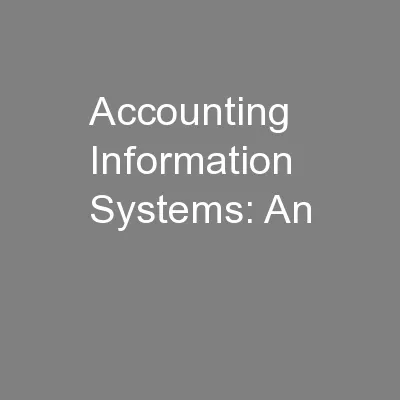

O verview Chapter 1 1 1 Learning Objectives Distinguish between data and information Understand the characteristics of useful information Explain how to determine the value of information ID: 317643
Download Presentation The PPT/PDF document "Accounting Information Systems: An" is the property of its rightful owner. Permission is granted to download and print the materials on this web site for personal, non-commercial use only, and to display it on your personal computer provided you do not modify the materials and that you retain all copyright notices contained in the materials. By downloading content from our website, you accept the terms of this agreement.
Slide1
Accounting Information Systems: An Overview
Chapter 1
1
-1Slide2
Learning Objectives
Distinguish between data and information:
Understand the characteristics of useful information.Explain how to determine the value of information
.
Explain fundamental
decisions an organization makes:Understand basic information needed to make them.Identify the transactional information that passes between internal and external parties and an AIS.Describe the major business processes present in most companies.Explain what an accounting information system (AIS) is and describe its basic functions.Discuss how an AIS can add value to an organization.Explain how an AIS and corporate strategy affect each other.Explain the role an AIS plays in a company’s value chain.
1-
2Slide3
Data vs. Information
Data are facts stored in the systemA fact could be a number, date, name, and so on.
For example: 2/22/14
ABC Company, 123,
99, 3, 20, 60
1-3Slide4
Data vs. Information
The previous slide just showed facts, if we put those facts within a context of a sales invoice, for example, it is meaningful and considered information
. Invoice Date : 2/22/14
Invoice #:
123
Customer: ABC companyItem # Qty Price99 3 $20 Total Invoice Amount $601-4Slide5
Value of Information
Information is valuable when the benefits exceed the costs of gathering, maintaining, and storing the data.
Benefit (i.e., improved decision making) > Cost (i.e., time and resources used to get
the information)
1-5Slide6
What Makes Information Useful?
There are seven general characteristics that make information useful:
Relevant: information needed to make a decision (e.g., the decision to extend customer credit would need relevant information on customer balance from an A/R aging report)Reliable:
information free from bias
Complete:
does not omit important aspects of events or activities Timely: information needs to be provided in time to make the decision1-6Slide7
What Makes Information Useful?
Understandable: information must be presented in a meaningful manner
Verifiable: two independent people can produce the same conclusionAccessible: available when needed
1-
7Slide8
Organizational Decisions and Information Needed
Business organizations use business processes to get things done. These processes are a set of structured activities that are performed by people, machines, or both to achieve a specific goal. Key decisions and information needed often come from these business processes.
1-
8Slide9
Transactional Information Between Internal and External Parties in an AIS
Business organizations conduct business transactions between internal and external stakeholders.
Internal stakeholders are employees in the organization (e.g., employees and managers).
External stakeholders are trading partners such as customers and vendors as well as other external organizations such as Banks and Government.
The AIS captures the flow of information between these users for the various business transactions.
1-9Slide10
Interactions Between AIS and Internal and External Parties
1-
10Slide11
Basic Business ProcessesTransactions between the business organization and external parties fundamentally involve a “give–get” exchange. These basic business processes are:
Revenue: give goods / give service—get cashExpenditure: get goods / get service—give cashProduction: give labor and give raw materials—get finished goods
Payroll: give cash—get laborFinancing: give cash—get cash
1-
11Slide12
What Is an Accounting Information System?
It can be manual or computerized
Consists of People who use the system
Processes
Technology (data, software, and information technology)
Controls to safeguard informationThus, transactional data is collected and stored into meaningful information from which business decisions are made and provides adequate controls to protect and secure the organizational data assets. 1-12Slide13
How Does an AIS Add Value?A well thought out AIS can add value through effective and efficient decisions.Having effective decisions means quality decisions
Having efficient decisions means reducing costs of decision making
1-
13Slide14
AIS and StrategyAn AIS is influenced by an organization’s strategy.A strategy is the overall goal the organization hopes to achieve (e.g., increase profitability).
Once an overall goal is determined, an organization can determine actions needed to reach their goal and identify the informational requirements necessary to measure how well they are doing in obtaining that goal.
1-
14Slide15
AIS in the Value ChainThe value chain shows how the different activities within an organization provide value to the customer.
These activities are primary and support activities. Primary activities provide direct value to the customer.Support activities enable primary activities to be efficient and effective.
1-
15Slide16
1-
16Slide17
Key Terms
System
Goal conflictGoal congruenceData
Information
Information technology (IT)
Information overloadValue of informationBusiness processTransactionTransaction processingGive-get exchangeRevenue cycleExpenditure cycleProduction (conversion) cycleHuman resource/payroll cycleFinancing cycleGeneral ledger and reporting systemAccounting information system (AIS)Predictive analyticsValue chainPrimary activitiesSupport activities
Supply chain
1-
17